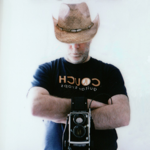
If necessity is the mother of invention, then mediocrity is the mother of modification.
Over the years, I have steadily come to look upon my Lomography Belair X 6-12 Jetsetter camera with growing disappointment. My disenchantment with the Belair rests upon two chief complaints:
- The plastic lenses are terrible. They are quite soft, especially along the edges, and the photos are often out of focus—rarely in a good way.[1]Yes, I know they are meant to be out of focus, but instead of being creatively out of focus, they’re just plain old blurry! To compensate, Lomography released two Belairgon glass lenses.[2]Film Advance wrote an excellent 4-part review of the Belair and its lenses, including the Belairgon 90mm lens. The lenses went a long way to solving the issue, but I couldn’t afford them at the time. Sadly, they have not been available for years, not even on the used market.
- The fastest shutter speed is 1/125 of a second.[3]You can find the Belair’s technical specifications here. This puts some serious limitations on using the Belair on a sunny day when the camera is loaded with high-speed film. While the Belair will allow ISO settings up to 1600 for shooting in low light, the 1/125 shutter speed means that if you follow the sunny-16 rule,[4]Sunny-16 is the name for the rule of thumb when shooting manually on a sunny day: set the camera’s aperture to f/16 and the shutter speed to the inverse value of the ISO. For example, if the ISO is 100, then the shutter speed is 1/100 second. then you’re limited to shooting with ISO 125 film in bright sunshine. To avoid overexposed photos, you can’t shoot ISO 800 film on a sunny day at the Belair’s maximum shutter speed unless you tape an ND filter to the lens.[5]The Belair’s lenses only have two aperture settings (f8 and f/16) and lack a filter thread. And since you can’t operate the camera with one hand (unless you use a tripod), taping an ND filter to the camera is the only viable option. Ultimately, this issue makes it a challenge to use the Instant Back because it uses Instax Wide film which has an ISO of 800. To solve this problem, Lomography supplies ND filters[6]The ND filters are just thin plastic gels that you must place underneath the lens. with its Instant Back and recommends using them with lower ISO settings when shooting Instax Wide. But once the ND filters are in place, the camera’s auto-exposure system will not work as expected since it is not TTL (through the lens). As Lomography admits, the Belair with Instant Back “is not fully automatic” and requires “time, reading and experimentation” to learn how to use it.[7]For a better understanding of the workarounds and patience required to use the Instant Back, check out Lomography’s Ready to Shoot Guide which describes all sorts of ND filter / ISO setting combinations to use in various lighting situations when shooting the Belair with Instax. In other words: the slow shutter speed is a serious design flaw.
If necessity is the mother of invention, then mediocrity is the mother of modification. I began thinking of ways to mitigate the issues by mounting a proper lens and shutter to my Belair. It wasn’t long before I found inspiration in Nick Lyle’s Lomoigtländer and the Homemade Camera Podcast. Nick mounted a 105mm Voigtar lens to his Belair and I aimed to do something similar. After patiently waiting for the right lens to appear on eBay, I bought an old Kodak Special Six-20 folding camera with a 100mm Anastigmat Special lens mounted in a Compur Rapid shutter. When it arrived, I carefully removed the shutter & lens and mounted them to my Belair. Thus was born the much-improved Bel-Aire ‘Special’!
To test my creation, I decided that shooting Instax Wide would give me immediate verification that my modification worked. I took a variety of photos, some using the Belair’s shutter and some using the Compur Rapid shutter. It quickly became apparent that even with the Compur Rapid’s aperture stopped down to compensate for the 1/125 shutter speed, the Belair would never give decent results. Photos were always over or underexposed. So I put the Belair in bulb mode and taped the shutter release down to keep the shutter open. Then I metered the light using an iPhone app, adjusted the settings on my Compur Rapid shutter, and snapped some photos.


![]()
Footnotes




